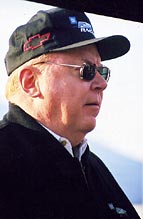|
<<
PREVIOUS PAGE
 DRO:
Is the Saturn project with Jim Epler part of
GM's racing? DRO:
Is the Saturn project with Jim Epler part of
GM's racing?
FS: To a minor
degree. We're giving them some tech help, obviously.
We're giving them some engine parts from us
because we build them real high performance
engine parts right now; it's just starting.
They got in late compared to us, so I would
say that that's gonna grow over time just like
other teams and other people deciding that that
may be something to investigate from a racing
standpoint trying to provide assistance to a
lot of people. I tell you one of the big things
that we've done, that nobody's done, is we put
this Ecotec how-to handbook together. We're
giving the handbook away and we're giving a
CD away to anyone who wants it. If you've got
the wherewithal to build a race engine, it's
got every part number, the 800 telephone number
for where we got the parts, how we built the
parts, how you put the parts together.
At the end of your exercise you end up with
a thousand horsepower race engine. Nobody's
done that. We're trying to spread the good word
about bullet-proof small four cylinder engines,
which really could be a cornerstone for a lot
of drag race products.
DRO: This will
all be available through GM Racing?
FS: Absolutely.
DRO: At the LA
Auto Show this year Toyota debuted the Scion,
which basically you can order and customize
from Toyota right off the internet, just the
way you want it. Is that sort of the future
for this market?
FS: I don't know.
Obviously this group is tuned into the internet.
It's their primary means of communication. When
you look at the drag racer, sport compact scene,
it's internet communication or magazine communication,
or I'll say word of mouth or going to club meetings;
they don't read USA Today, it's not in the vocabulary
there but that's ok, there's nothing wrong with
that. We'll be doing a lot more communication
through the internet, but whether you can buy
a car necessarily and that's a ways down the
road I think but the parts, you can buy parts
today through GM Performance Parts on the internet.
DRO: Has there
been any effort with GM Racing to steer these
kind of racers away from the street and more
into the drag strip?
ADVERTISEMENT
 |
|
FS:
Well, there is and I think just the main reason,
it's one of the reasons we're here, to show
you can take a production vehicle, race it.
We've had safety seminars we've had one in Englishtown
this past September open to the public to talk
about helmets, five and six part harnesses,
and all the pieces that we've got on the car,
we had our Safety Engineer Tom Gideon there
to put their hour long presentation on. We're
coming back next month in Las Vegas, the NHRA
race there the first one - doing it all over
again. So the message is one of "Yeah, let's
race, let's have some fun, but let's be safe
to do all this." We don't need to be doing this
on the street. Yeah, hop up your car, have some
fun with it - you race at the race track.
DRO: Like they
did in the late 1940s and early '50s.
FS: There's nothing
new here. This is the same movement that we
had in the '50s and '60s, but instead of a small
block with the glass-packed mufflers, we got
a 4 cylinder you tune with your laptop and it's
got a Borla exhaust. The things that people
did, I'll say the kids did in the '50s and '60s
are the same things that kids are doing now,
the parts are different. The front tires are
smoking not the rear ones, it's a four cylinder
not a V8, but they're tuning them up, they're
doing the tires, the trick wheels, the brakes,
the paint, the graphics, it's the same movement.
< MORE STORIES >
|